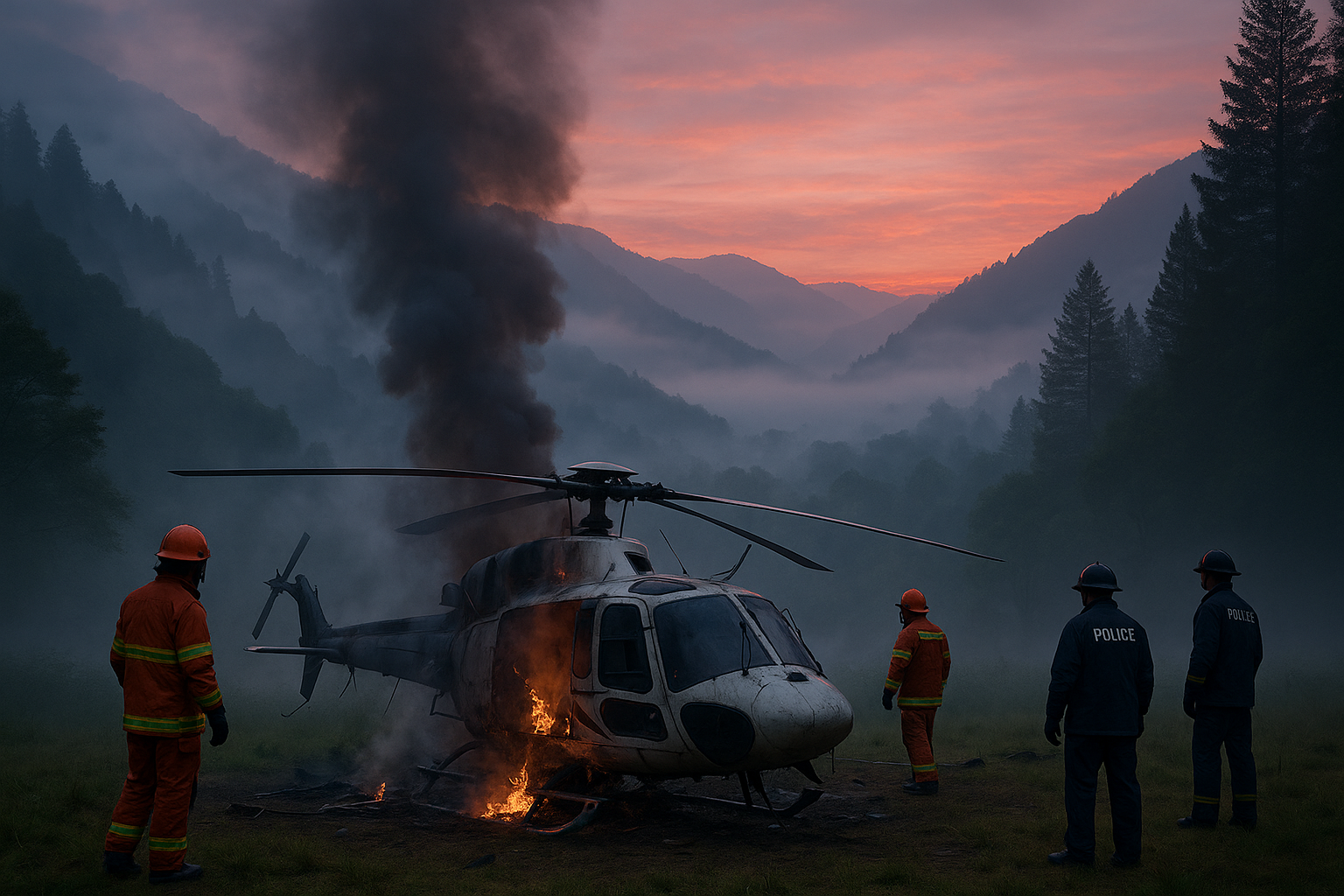Introduction: Devotion Turns to Disaster in Uttarakhand
On June 15, 2025, a helicopter airplane crash in Uttarakhand, India, sent shockwaves across the nation. A private chopper ferrying pilgrims from Kedarnath to Guptkashi plunged into the mountainous terrain near Gaurikund, killing all seven onboard, including a toddler, a 10-year-old girl, and the pilot. The crash is the fifth aviation-related accident on the Char Dham pilgrimage route in under two months, prompting widespread concern over air safety in this region.
This article delves into the tragic incident, its causes, the victims, and the regulatory lapses that have led to public outrage and urgent safety reviews.
Timeline and Location of the Helicopter Airplane Crash
Early Morning Flight Ends in Catastrophe
The helicopter, operated by Aryan Aviation, took off at approximately 5:15 AM on Saturday from Kedarnath, heading to Guptkashi. The journey was part of the Char Dham Yatra, a holy pilgrimage route in the Himalayas. Around 5:30 AM, the aircraft crashed in the Jangalchatti area near Gaurikund, a heavily forested region known for treacherous terrain and unpredictable weather.
Eyewitnesses reported hearing a loud noise and seeing smoke rising from the crash site moments later.
Aircraft Details
-
- Model: Bell 407 helicopter
-
- Operator: Aryan Aviation
-
- Flight Route: Kedarnath to Guptkashi
-
- Passengers: 6 (including two children)
-
- Pilot: Lt Col (Retd.) Rajveer Singh Chouhan
The helicopter was reportedly flying in low-visibility conditions, which might have led to spatial disorientation or a navigational error.
Casualties and Victim Identification
All Lives Lost
All seven people on board were confirmed dead by rescue teams that reached the site within two hours. The victims included:
-
- Pilot: Lt Col Rajveer Singh Chouhan, an experienced ex-army officer
-
- Passengers: A family from Delhi, including a man, his wife, two children (ages 10 and 2), and two elderly relatives
The recovered bodies were severely charred due to post-crash fire and were identified using documents and belongings.
Community in Mourning
Lt Col Chouhan, a decorated veteran and father of two, was well-known in Jaipur, where news of his death led to an emotional outpouring. The victims’ relatives, some of whom were already in Uttarakhand, expressed grief and questioned why flights were allowed under such dangerous weather conditions.
What Caused the Helicopter Airplane Crash?
Preliminary Findings
The helicopter airplane crash is believed to have been triggered by a combination of environmental and technical factors:
-
- Low Visibility: Dense fog and cloud cover were reported around the time of the crash.
-
- Pilot Error or Disorientation: The pilot may have misjudged altitude or failed to clear surrounding ridges.
-
- Lack of Ground Radar Support: The remote region lacks advanced air traffic monitoring systems.
-
- High Flight Frequency: Pilgrimage seasons often see over 100 flights per day, putting pressure on operators and infrastructure.
While sabotage or engine failure hasn’t been ruled out, weather-related factors are being treated as the primary cause until the final DGCA report is released.
Regulatory Backlash and Suspension of Operations
Aryan Aviation Grounded
Following the crash, the Directorate General of Civil Aviation (DGCA) immediately suspended Aryan Aviation’s operations in Uttarakhand. A special audit is underway to assess their aircraft maintenance records, pilot certifications, and flight scheduling processes.
Char Dham Yatra Flight Rules Under Review
-
- Authorities are considering reducing daily flight quotas.
-
- Strict weather compliance protocols are being drafted.
-
- The Indian Meteorological Department (IMD) is being roped in to issue real-time weather alerts.
-
- The Tourism Ministry may mandate GPS-based flight monitoring systems for all Char Dham operators.
Uttarakhand CM Pushkar Singh Dhami assured the public that “strict action will be taken against any negligence.”
Aviation Safety Crisis in the Himalayas
A Series of Crashes Raises Alarms
This helicopter airplane crash is not an isolated incident. It follows four other crashes in the past six weeks, all involving helicopters flying on the same pilgrimage route. Together, these crashes have claimed over 20 lives.
Experts believe the following systemic issues are to blame:
-
- Outdated air traffic systems
- Outdated air traffic systems
-
- Inadequate pilot rest and training
- Inadequate pilot rest and training
-
- Loose enforcement of aviation laws during peak pilgrimage seasons
- Loose enforcement of aviation laws during peak pilgrimage seasons
With over 2.5 lakh pilgrims flying during the Char Dham Yatra, safety must now become the top priority.
Is Flying Still Safe?
Though aviation remains statistically safe, helicopter operations in mountainous terrain carry unique risks. Unlike airplanes, helicopters can fly closer to ridges and valleys, which makes them more vulnerable to turbulence, downdrafts, and terrain masking—particularly when flying in marginal visual conditions.
Voices From the Ground
Locals near the crash site were among the first responders. “We heard a loud bang and rushed to the jungle,” said Gaurikund resident Harish Rana. “But by the time we reached, everything was burning. It was horrifying.”
Pilots and aviation experts have called for limiting the number of daily flights and setting stricter rules for visual flying. “This is not about tourism; this is about saving lives,” said one former DGCA official.
Conclusion:
A Wake-Up Call for Indian Aviation
The helicopter airplane crash in Uttarakhand is a heartbreaking reminder of how quickly a spiritual journey can turn tragic. As India’s aviation industry expands into high-risk zones like the Himalayas, safety protocols must evolve too.
From stricter oversight to improved technology, multiple solutions are needed—urgently. For the grieving families, no action can undo their loss. But for the thousands who will fly these routes in the coming months, stronger regulation might be the difference between life and death.
Until then, the skies over the Char Dham remain under watch, with hope that such a disaster will never be repeated.
FAQs
What is the most common cause of a helicopter crash?
u003cstrongu003ePilot erroru003c/strongu003e is the leading cause of helicopter crashes. This includes poor decision-making, spatial disorientation, or misjudging weather conditions. Other significant factors include u003cstrongu003ebad weatheru003c/strongu003e, u003cstrongu003emechanical failureu003c/strongu003e, and u003cstrongu003ecollisions with terrainu003c/strongu003e in mountainous regions.
Which airline has had 0 crashes?
Several airlines have an impeccable safety record with u003cstrongu003ezero fatal crashesu003c/strongu003e in the jet age. Notable examples include:u003cbru003eu003cstrongu003eQantas Airwaysu003c/strongu003e (Australia)u003cbru003eu003cstrongu003eHawaiian Airlinesu003c/strongu003eu003cbru003eu003cstrongu003eVirgin Atlanticu003c/strongu003eu003cbru003eu003cstrongu003eEmiratesu003c/strongu003eu003cbru003eu003cstrongu003eRyanairu003c/strongu003e
What is the safest airline in the world?
According to 2024 aviation safety rankings by AirlineRatings.com, the u003cstrongu003esafest airlineu003c/strongu003e in the world is:u003cbru003eu003cstrongu003eQantas Airwaysu003c/strongu003eu003cbru003eAir New Zealandu003cbru003eEtihad Airwaysu003cbru003eQatar Airwaysu003cbru003eSingapore Airlines
Are helicopters more dangerous than airplanes?
Statistically, u003cstrongu003ehelicopters have a higher accident rate than commercial airplanesu003c/strongu003e, especially in high-risk environments like mountains or during short-range flights. However, with skilled pilots and proper maintenance, helicopters can be very safe for transport, rescue, and tourism operations.

